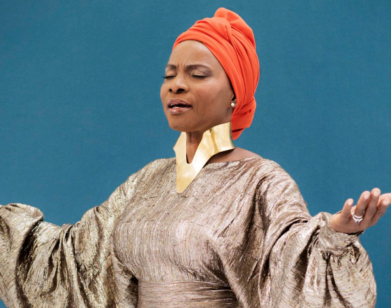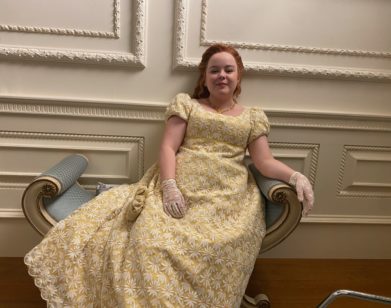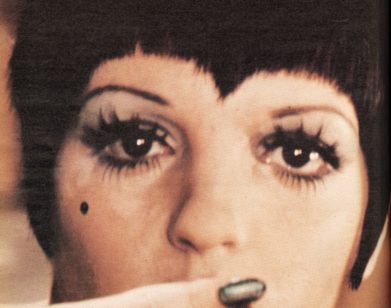In a New Production of an Old Play, Fefuand Her Friends Go Beneath the Surface
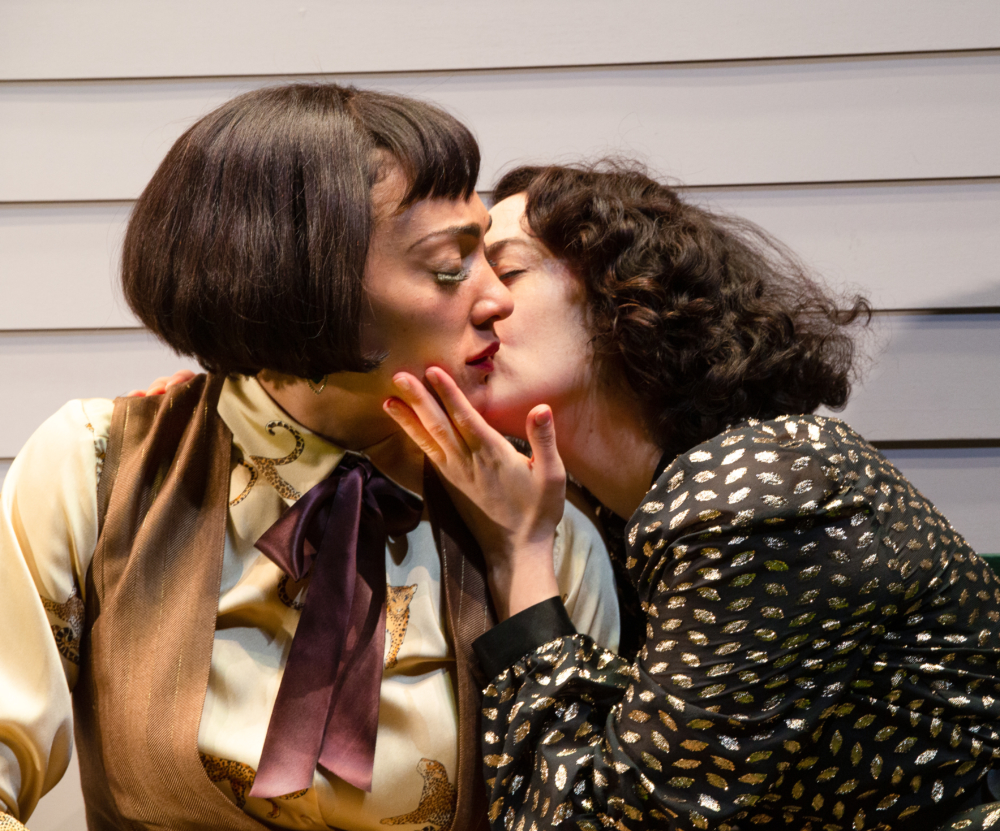
Amelia Workman as Fefu and Helen Cespedes as Emma. Photo by Henry Grossman.
“Have you ever turned over a stone in damp soil?” the titular character of María Irene Fornés’ Fefu and Her Friends asks in her first scene, hand on hip in one of the four brightly bohemian rooms that make up a complex stage. “That which is exposed to the exterior is smooth and dry and clean,” she explains, “underneath is slimy and filled with fungus and crawling with worms. It’s another life that is parallel to the one we manifest.” Until December 8th, director Lileana Blain-Cruz, Fefu, and her seven friends are manifesting both that smooth exterior and its squirming underbelly with gusto at Polonsky Shakespeare Center, Theater for a New Audience’s Brooklyn home.
It’s a conjuring few have attempted: only Fornes herself, who passed away last year, has ever professionally staged her best-known piece. Like so many others (Slave Play‘s Jeremy O.Harris, for example, is a noted Fefu devotee), Blain-Cruz—a Princeton grad who won an Obie for directing The Death of the Last Black Man in the Whole Entire World AKA The Negro Book of the Dead—fell in love with the text on the page. “When I read it I thought, ‘Why is nobody doing this? Why is nobody doing this play?'” she tells me over Blue Bottle coffee on a grey New York day. It’s a question that needs asking—not only because, in the era of the Bechdel Test, Fefu and Her Friends boasts a cast made up entirely of women—but because there are elements of this production that beg to be seen to be believed. Written well before the rise of interactive theater, Fefu is a labyrinthine work. That’s not only to say it is complex, circular, or challenging (though it is also all of these things): it is literally a labyrinth. Set in the 1930s at a gathering of women in their friend’s country home, the first and third parts of the production function in the usual way, with the audience observing the women as they laugh, cry, kiss, bleed, and heft a double-barrelled shotgun in Fefu’s living room. The second part, however, requires that the audience rise from their seats and move around the theater in order to watch four separate scenes in four separate rooms: a dimly lit study, a pristine lawn, a submerged bedroom, and a kitchen that smells warmly of whatever is simmering on the stove.
The experience is at once intimate and overwhelming. At my production, I watched as one audience member stumbled briefly over one of the croquet wickets on Fefu’s “lawn,” and Fefu herself [played by Amelia Workman] reached out to offer a steadying hand. Conventional boundaries dissolve as the audience moves from room to room. Stepping over the skeletal spines of stage lights to find a former couple toe-to-toe in the kitchen, dodging dangling ropes to observe a character recalling a dream in the study, and leaning over plexiglass to watch a prone woman hallucinate in a basement bedroom, one gets the sense that this is the very overturning Fornés intended. It is a look under and inside of not only theater itself, but eight women who fully inhabit each discrete space they occupy. For Fefu, for Fornés, and for Blain-Cruz, there’s something vital about making room(s) for all the untamed, teeming life that thrives beneath serene surfaces. “If you don’t recognize it,” Fefu warns, “it eats you.”
Here, Blain-Cruz and I discuss what it means to witness that life, how different spaces work to contain it, and how Fefu and Her Friends ultimately rests upon the women at its center.
———
JADIE STILLWELL: I want to first talk about your earliest experience with this play. It’s never staged, really—this is only the second time ever, professionally speaking. How did you first encounter Fefu and her Friends?
BLAIN-CRUZ: I first read it in grad school. I was working on Gertrude Stein’s Dr. Faustus Likes the Lights, and Al Carmine worked on that. I wondered, “What else did Al Carmine work on?” And I was like, “Oh, [María Irene] Fornés wrote a musical? It’s called Promenade? What?” Then I read that and I thought, “What the fuck? This is amazing.” Everybody talks about Fefu and her Friends, so then I read that. It’s crazy as a director. You hear so many people being like, “I need a play with like eight women in it.” I wondered, “Why is nobody doing this? Why is nobody doing this play?” I mean, I get it. There’s a sense of it being enigmatic. It doesn’t follow a linear structure. But it’s so complicated and alive and beautiful and such a rigorous study of women that it’s mind-boggling to me that it isn’t done more often. I was also super thrilled about it because she was doing this interactive theater thing in the ’70s, moving people around space, you know?
STILLWELL: Which didn’t really happen then.
BLAIN-CRUZ: It didn’t really happen then, and now we’re like, yeah, moving people around, sure. It was striking to me that she had already been experimenting.
STILLWELL: I feel like I had sort of an inverse experience with the play because I read it only after I saw it. One of the things I became interested in after seeing it live was that feeling of moving around these distinct spaces, and the idea of the environment as a character unto itself. How did you conceptualize the role of the environment and the role of the audience?
BLAIN-CRUZ: One of the things that I loved about the play is feeling like there is no one unified perspective. So when you look at these women, you can’t say that you have an authoritative perspective on them because you’re operating within a completely different relationship to time and space.
STILLWELL: It’s subjective.
BLAIN-CRUZ: Everybody’s experience is unique. I think in terms of creating the space, there’s also something about how the body functions as an organism. All of the spaces are connected. Working with Adam Rigg, the set designer, we thought a lot about how to maintain that interconnectedness. There was one point in the set design where we were like, “One room’s over there and one is all the way over here…” But we decided, no, they have to be unified in some way.
STILLWELL: Like a body.
BLAIN-CRUZ: Literally a body. Then we thought, too, about Julia’s room, about the dynamics of space, about the size of the audience and about where, emotionally, she could live. That’s where we ended up kind of putting her somewhere almost subterranean. It follows the metaphor that Fefu introduces at the beginning of the play of the rock, the smooth surface, and then the worms underneath. We also thought about space as a container. One of the things that’s always true when you’re asked to get up and move is that everybody’s suddenly aware of their bodies. They’re aware of the people that they’re sharing space with. I think we had this idea of like just being open about the theater space as a container, which is why, for example, the lights were exposed. It’s just like everything is open.
STILLWELL: You’re seeing that space underneath the rock the whole time. You’re seeing the worms. I was really interested in the setting of Julia’s room, underneath the main stage, because it felt almost like the audience is complicit in something, in looking down on her through plexiglass. Was that feeling something you considered?
BLAIN-CRUZ: Totally. In the original stage directions, Fornés writes that there’s a bedroom, but it’s in a storage closet or something, and that Julia is wearing a medical garment. I was like, “Great. This is an abstracted space. Awesome. Thank you so much. Let me play with that.” So we created the trap room. There’s something that always moves me when Julia later is like, “Hallucinations are real. This is very real to me.” We were thinking a lot about how looking at her experience through the plexiglass is in some ways like the doctors, the judges that she talks about. So you’re sympathizing with her but you’re also separated from her. And you are also the very real bodies that she feels are looking down upon her.
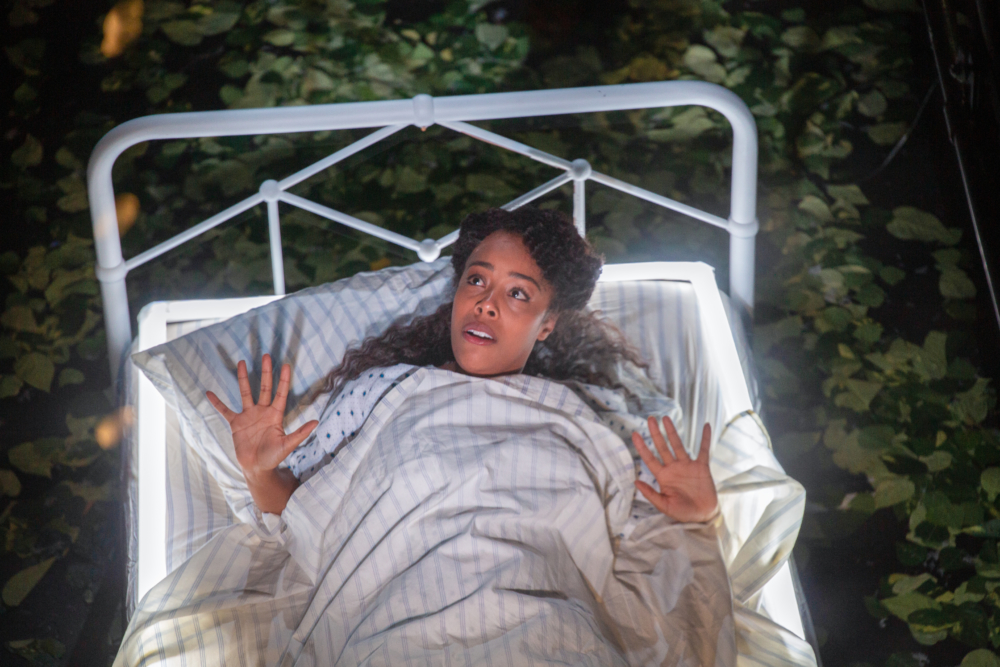
Brittany Bradford as Julia. Photo by Henry Grossman.
STILLWELL: It validates her experience in that way. It feels like a lot of the way the audience was used in space and the way the actresses moved in that space broke down or transgressed boundaries. It seems to speak to women’s experience with or of boundaries more broadly.
BLAIN-CRUZ: Exactly. You’re like, “Right. I love this space. It’s amazing, but I’m also trapped in this space and this is containing.” There’s that a kind of ambiguity living between the two.
STILLWELL: It emphasizes the audience as a fourth wall. I mean, the audience is always the fourth wall in theater, but as we’re moving around those smaller spaces, you really do become that final wall. So you’re creating an enclosed boundary while you’re stepping inside of it.
BLAIN-CRUZ: You understand what I was trying to make. Thank you.
STILLWELL: It was different from any experience I’ve ever had in an interactive theater space before. I read an interview with Fornés on JSTOR, as one does, where she talked about how she didn’t write in the different spaces in the play until she saw the theater where it would be performed and found those spaces already there. The idea of reverse engineering that essential part of the play is so fascinating to me, because you had to apply those sensibilities to a space that wasn’t necessarily built for it.
BLAIN-CRUZ: It was super challenging. I think that reading that experience of Fornés thinking, “Great, there’s a study in this theater. There’s a kitchen. A bathroom. This living room is great. Oh, there’s a piano, let’s use it,” and playing with the materials she had is really amazing. I think for TFANA, it’s a beautiful, open vertical space, but people take up room. So trying to figure out how to maintain that sense of integrity of the space that Fornés had was our challenge, which is why all of the rooms interconnecting felt really important to us.
STILLWELL I know that Fornés directed the first staging herself. Did you feel like you were in constant conversation with the history of this play and its first production?
BLAIN-CRUZ: I was like, “Fornés, hey girl. I think you’re amazing. I’m going to take some cues from you.” We watched this documentary, The Rest I Make Up, which is an amazing documentary about Fornés’ life. What it does, really remarkably, is show her spirit. I think I, along with the cast and the company, especially Amelia [Workman], were really working hard to honor that spirit, because it’s like, here was a woman who was truly experimenting. She won like nine Obies. She’s done so much and influenced so many people, and yet her play wasn’t being done. That felt insane. I felt like the uniqueness of the fact that it was actually happening meant that there was an awareness of where it came from.
STILLWELL: I also feel like there’s a kind of timelessness to the production. Both to the play itself and to the text. I know it’s set in the 1930s, but it was written in the ’70s. I felt like the staging, the costuming, the design, were all sort of outside of time, while remaining very specific to that ’30s setting.
BLAIN-CRUZ: It’s funny. When I was, again, perusing through JSTOR articles, as one does …
STILLWELL: As one does.
BLAIN-CRUZ: There were some people that were saying, “The 1930s didn’t matter. This is a play for the ’70s.” You read reviews saying, “It feels very contemporary.” In another interview, Fornés talked about how she just liked the idea of a moment pre-Freud where people just said what they meant. I was like, “Oh, that’s kind of interesting. Like I’m saying what I feel in the particular moment and there’s no pretending. I don’t lie.” There’s a real honesty amongst these women. They may not say everything that they’re feeling in a particular moment, but they’re truthful.
STILLWELL: They take each other completely seriously. And that can be dangerous, too.
BLAIN-CRUZ: Exactly. I think that’s the thing that’s useful about the ’30s for this group of women who essentially operate outside of the status quo, who are educators, who are intellectuals, who are lesbians. There’s that pressure of the ’30s as a container within which Fefu’s home becomes a kind of safe space. I feel like that still exists today. There are still spaces where we have to create a community because there’s a lot of pressure on the outside that doesn’t make us feel welcome. So in thinking about time and thinking about how things resonate throughout time, you can take, for example, Cecilia’s speech in the third act where she talks about how we shouldn’t crush what’s unusual in us. We shouldn’t be condensing ourselves down to the common denominator, which you can absolutely relate to our moment that we’re in right now, where we’re trying to, in some ways, eliminate all the complexities of our existence. So that’s what I mean when I say the text or the conversations are universal. The ’30s are a container that allows us in some ways to feel like the residents, too.
STILLWELL: The idea of a container brings up something else I thought about, in terms of the role of the audience again. You’re fitting a lot of people in these small spaces, right? The experience of being crowded in with people felt substantial. You’re sort of bouncing around off of each other in there, and you can hear the scenes in the other rooms but can’t see them.
BLAIN-CRUZ: That felt really important. We were rehearsing in a rehearsal room where there were no walls. So there was one point in rehearsal where we were running all four scenes at the same time, and everybody was like, woah. But the thing that was useful about that was that everybody had to maintain the integrity of their own scene while also feeling the relationships between the other scenes. Amelia said something great. She was like, “It’s like a real house party.” Where you hear other people laughing and you’re like, “What are you laughing about?” But the crowding of the audience was important, too. It was like yes, there is something intimate when you’re literally shoulder to shoulder with strangers. It might drive some people crazy, but I think it’s good. There’s a sense of community around you.
STILLWELL: It does break down to some kind of boundary to have that. Even to interact with people as we’re moving from place to place is different from your typical theater experience where you’re sitting alone in silence. It’s just you. This play is often talked about as displaying how women behave when no one is watching, but how does the role of this very present, close-up audience complicate that idea?
BLAIN-CRUZ: I think when you think about what’s happening inside of the play, we’re just getting to witness relationships happening together. When I think of no one watching, I think about how we’re just having relationships and experiencing it in time and we’re talking about ideas that are important to us. We’re not censoring ourselves in the way that if we were out in the public world with certain expectations of ourselves, we might have to censor or feel the wrath of an opinion that may not be popular or accepted. Relationships like that of Paula and Cecelia [a couple], for example, can explode inside of a space like that.
STILLWELL: You said witness, which I think is an interesting word in this context. I know Fornés talked about the audience being witnesses in this play, which feels distinct from just being watchers. What does that mean to you for the audience to be a witness?
BLAIN-CRUZ: It’s funny. I think, if we think about it from Julia’s position, none of the other characters in the house see what she goes through but us. Only we get to witness that. It’s a little bit what you talked about, how we’re implicated inside of that space. But I think on the other side, the integrity or the joy of the piece, is that these women are not having to perform roles that society is asking of them in this particular house. They get to just be. There’s still, of course, such a conscientiousness around women’s bodies, around ownership of the bodies, around how we comport ourselves, what that all means. So to witness a space where people just get to be who they are…They’re not having to perform. There are some pieces where it’s like, “I am performing your idea of who and what you think I am and what you think I should be.”
STILLWELL: Maybe this is a gentler kind of witnessing, where it doesn’t impose anything. It acknowledges their reality. It’s interesting that the play is explicitly set in a very domestic sphere, in this house and its kitchen and living room. But there’s no inclination to shutter any of the women into any of particular domestic roles.
BLAIN-CRUZ: It’s the brilliance of the writing. Fornés was questioned about this over her life so many times. Like, “Are you a feminist? Are you a feminist?” And she purposely eschews the label, not because she’s against it, because of course she supports it, but because she is constantly reaffirming that women who are at the center of things can be women at the center of things. As opposed to other plays where we put people in specific roles: sister, mother, daughter, wife. In this text, it’s like, “No.” It’s not that these women wouldn’t have been those things or have had those relationships. It just isn’t the central mode of understanding them. Their relationality is purely to themselves as individuals.
STILLWELL: It’s entirely on their own terms.
BLAIN-CRUZ: They are subject and subject. We talk so much about objectification. Fornes says, “No, everybody is a subject. Everybody is a subject.”
STILLWELL: That’s revolutionary in a lot of ways.
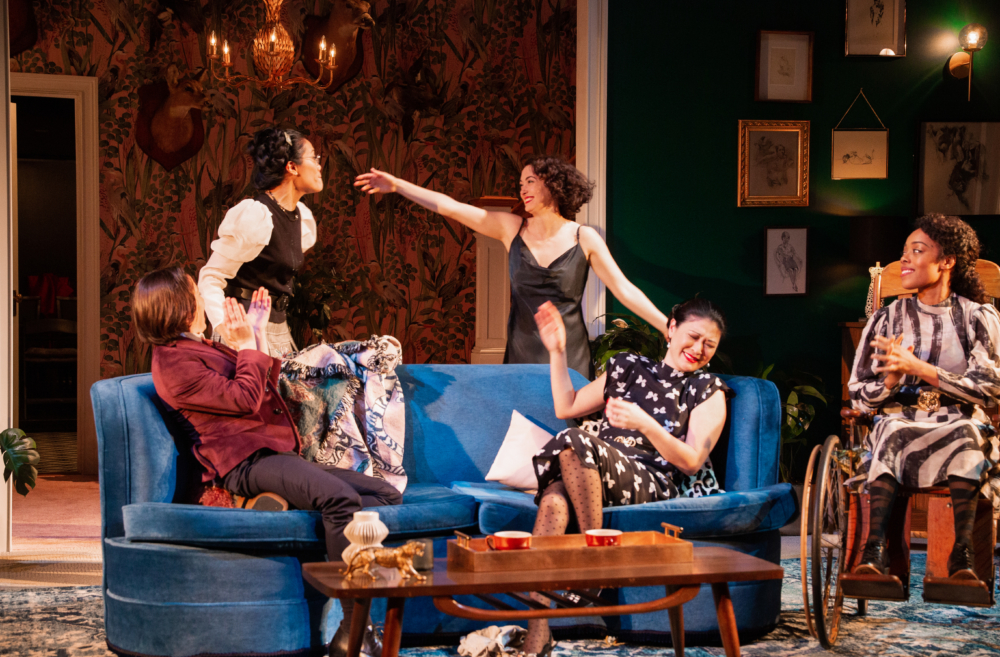
Ronete Levenson as Sue, Lindsay Rico as Paula, Helen Cespedes as Emma, Jennifer Lim as Cindy, and Brittany Bradford as Julia. Photo by Henry Grossman.
BLAIN-CRUZ: It sounds so basic, but I’m always amazed that there’s a space for these characters. That there’s space for somebody like Fefu to be tremendous, to be powerful, to feel like she’s 10 feet tall and also fucking ripped up and complicated inside. Because I don’t know about you, but that’s how I feel sometimes. One minute, I’m like, “Yes.” And then the next minute I’m like, “What is life?”
STILLWELL: “What is wrong with me?”
BLAIN-CRUZ: For somebody to put that on stage for people to be like, “Right. Like those two things can exist simultaneously in one person, in one body.” That’s pretty fucking amazing.
STILLWELL: Fefu as a character almost encapsulates the play as a whole in that way. She’s got a confidence and a theatricality to her, but so much complexity and so many paradoxes beneath the surface.
BLAIN-CRUZ: Exactly. Another director, Pam MacKinnon said, “Oh, this production is great because it actually embraced Fefu and her friends, you know what I mean? That they were friends.” I think that there’s sometimes a tendency to want to rip that apart. I heard Fornes was also responding to this film called The Women, with this play which is all about women taking each other apart. This is a kind of the antithesis of that.
STILLWELL: It feels very real. I think that a lot of the success of the production rests on that intimacy and chemistry between the women and the complexity of those relationships. We’re friends and we love each other and we’re friends and we hate each other. And it’s all fine. That’s okay.
BLAIN-CRUZ: Everything is so complicated, you know? But when women are with real friends, they can say absolutely nothing. They can share a look across the room and, just like that, something has happened.




